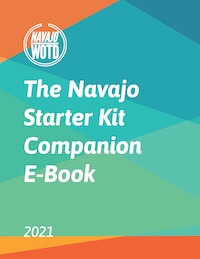hah ah ah
In English, ha’a’aah is commonly translated into ‘east.’ In the Navajo way, it refers to the sunrise – a consistent reminder of the underlying symbolism of the four directions.
If you’re familiar with the Navajo culture, then you’ve probably noticed that the number four is a recurring value, such as the four sacred mountains, the four types of corn, the four original clans, and so forth. The four cardinal directions follow in much the same fashion, with every quarter part representative of an important aspect of Navajo cultural understanding.
Navajo people will rise before the sun to witness the dawn, as it provides Navajo with the reminder that creativity and the senses lay the foundation for strong ideas and a better life. The light nurtures this mindset in a way that encourages personal development, and is attributed to be white light (white being one of the four colors).
So, if you think of east, think of sunrise. Then think of ha’a’aah to remind yourself that creativity and free-thinking are essential parts of Navajo cultural thought process.
